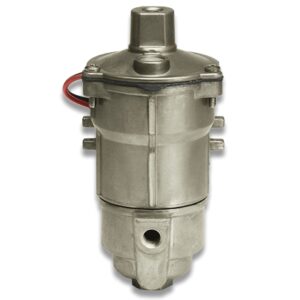Howdy All!
Actively planning an RCR build while waiting on kit delivery.
I keep going back and forth on a fuel system design. I plan on using a simple "returnless" fuel system feeding a Holly 4bbl @ 6PSI. The engine is rated at less than 500HP, so theoretically 41GPM is required at continous WOT.
I have combed the various threads on fuel pumps - types / flow rates / arrangments, each with various pros and cons in regards to noise, performance, reliability, simplicity, and aesthetics.
During my planning / research I noticed no one has discussed this type of pump...

This Walbro pump is rated at 43gpm, has an internal 70micron suction filter, can dry lift 48in, and has an internal check valve.
While not period correct, I do think this pump would be somewhat aesthetically pleasing if installed in a similar arrangement to the original car(s).
Does anyone have experience with this style Walbro pump? Stewart Warner has something near idenitcal, but with less features.
Actively planning an RCR build while waiting on kit delivery.
I keep going back and forth on a fuel system design. I plan on using a simple "returnless" fuel system feeding a Holly 4bbl @ 6PSI. The engine is rated at less than 500HP, so theoretically 41GPM is required at continous WOT.
I have combed the various threads on fuel pumps - types / flow rates / arrangments, each with various pros and cons in regards to noise, performance, reliability, simplicity, and aesthetics.
During my planning / research I noticed no one has discussed this type of pump...
This Walbro pump is rated at 43gpm, has an internal 70micron suction filter, can dry lift 48in, and has an internal check valve.
While not period correct, I do think this pump would be somewhat aesthetically pleasing if installed in a similar arrangement to the original car(s).
Does anyone have experience with this style Walbro pump? Stewart Warner has something near idenitcal, but with less features.


